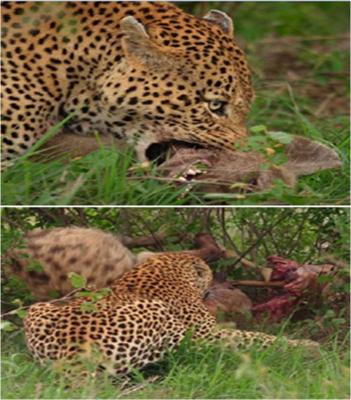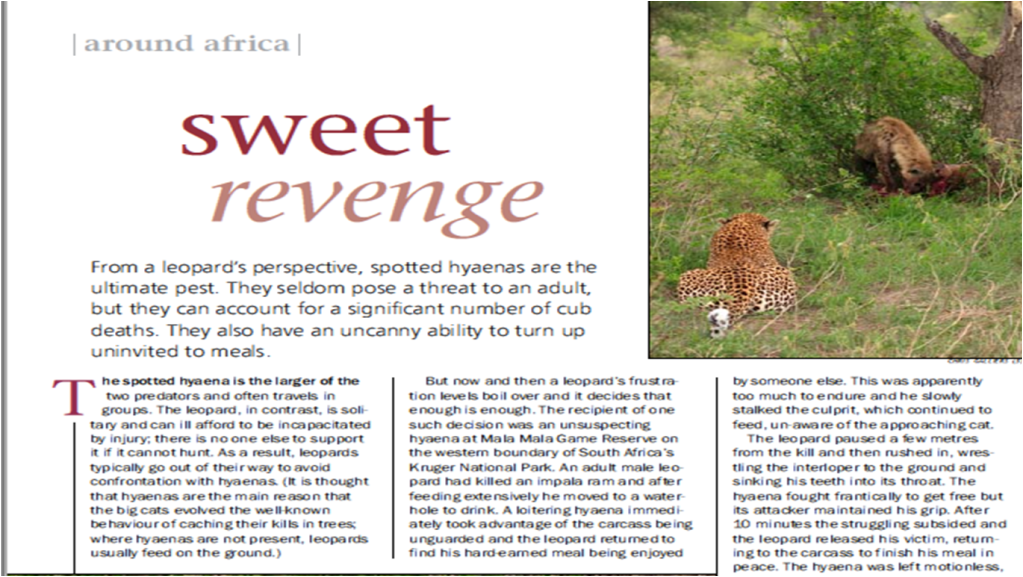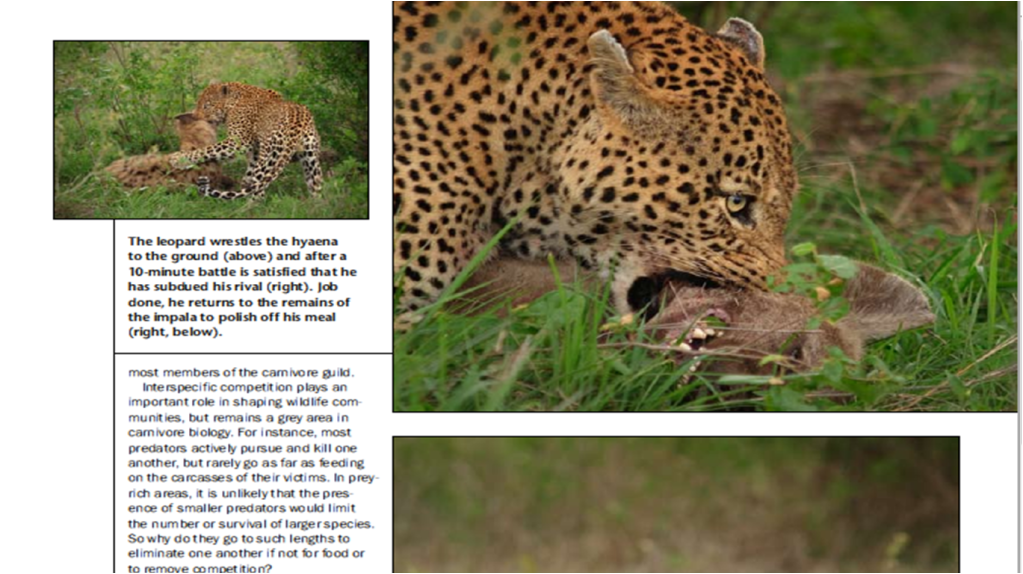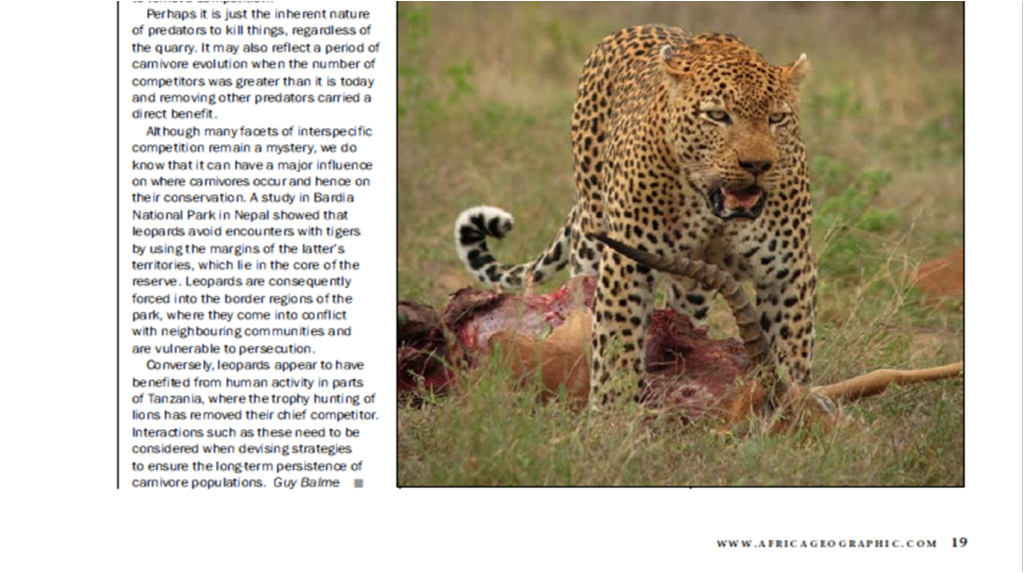Post by DinosaurMichael on May 31, 2013 1:57:04 GMT 5
Leopard - Panthera pardus
The leopard (/?l?p?rd/), Panthera pardus, is a member of the Felidae family and the smallest of the four "big cats" in the genus Panthera, the other three being the tiger, lion, and jaguar. The leopard was once distributed across eastern and southern Asia and Africa, from Siberia to South Africa, but its range of distribution has decreased radically because of hunting and loss of habitat. It is now chiefly found in sub-Saharan Africa; there are also fragmented populations in the Indian subcontinent, Sri Lanka, Indochina, Malaysia, Indonesia, and China. Because of its declining range and population, it is listed as a "Near Threatened" species on the IUCN Red List. Compared to other members of the Felidae family, the leopard has relatively short legs and a long body with a large skull. It is similar in appearance to the jaguar, but is smaller and more slightly built. Its fur is marked with rosettes similar to those of the jaguar, but the leopard's rosettes are smaller and more densely packed, and do not usually have central spots as the jaguars do. Both leopards and jaguars that are melanistic (completely black or very dark) are known as black panthers. The species' success in the wild is in part due to its opportunistic hunting behavior, its adaptability to habitats, its ability to run at speeds approaching 58 kilometers per hour (36 mph), its unequaled ability to climb trees even when carrying a heavy carcass, and its notorious ability for stealth. The leopard consumes virtually any animal that it can hunt down and catch. Its habitat ranges from rainforest to desert terrains. Leopards are agile and stealthy predators. Although smaller than other members of the Panthera genus, they are able to take large prey due to their massive skulls that facilitate powerful jaw muscles. Head and body length is between 95 and 165 cm (37 and 65 in), and the tail reaches 60 to 110 cm (24 to 43 in). Shoulder height is 45 to 80 cm (18 to 31 in). The muscles attached to the scapula are exceptionally strong, which enhance their ability to climb trees. They are very diverse in size. Males are about 30% larger than females, weighing 30 to 91 kg (66 to 200 lb) compared to 23 to 60 kg (51 to 130 lb) for females. Large males of up to 91 kg (200 lb) have been documented in Kruger National Park in South Africa; however, males in the South Africa's coastal mountains average 31 kg (68 lb) and the females from the desert-edge in Somalia average 23 to 27 kg (51 to 60 lb). This wide variation in size is thought to result from the quality and availability of prey found in each habitat. The most diminutive leopard subspecies overall is the Arabian leopard (P. p. nimr), from deserts of the Middle East, with adult females of this race weighing as little as 20 kg (44 lb). Other large subspecies, in which males weigh up to 91 kg (200 lb), are the Sri Lankan leopard (P. p. kotiya) and the Anatolian leopard (P. p. tulliana). The largest verified leopards weighed 96.5 kg (213 lb). Larger sizes reported are considered unreliable. The leopard's body is comparatively long, and its legs are short. Leopards show a great diversity in coat color and rosette patterns. Their rosettes are circular in East Africa but tend to be squarer in southern Africa and larger in Asian populations. Their yellow coat tends to more pale and cream colored in desert populations, more gray in colder climates, and of a darker golden hue in rainforest habitats. Overall, the fur under the belly tends to be lighter coloured and of a softer, downy type. Solid black spots in place of open rosettes are generally seen along the face, limbs and underbelly. Leopards may sometimes be confused with two other large spotted cats, the cheetah, with which it may co-exist in Africa, and the jaguar, a neotropical species that it does not naturally co-exist with. However, the patterns of spots in each are different: the cheetah has simple black spots, evenly spread; the jaguar has small spots inside the polygonal rosettes; while the leopard normally has rounder, smaller rosettes than those of the jaguar. The cheetah has longer legs and a thinner build that makes it look more streamlined and taller but less powerfully built than the leopard. The jaguar is more similar in build to the leopard but is generally larger in size and has a more muscular, bulky appearance.

Spotted Hyena - Crocuta crocuta
The spotted hyena (Crocuta crocuta), also known as the laughing hyena or tiger wolf, is a species of hyena native to Sub-Saharan Africa. It is listed as Least Concern by the IUCN on account of its widespread range and large numbers estimated at 10,000 individuals. The species is however experiencing declines outside of protected areas due to habitat loss and poaching. The species may have originated in Asia, and once ranged throughout Europe for at least one million years until the end of the Late Pleistocene. The spotted hyena is the largest member of the Hyaenidae, and is further physically distinguished from other species by its vaguely bear-like build, its rounded ears, its less prominent mane, its spotted pelt, its more dual purposed dentition, its fewer nipples and the presence of a pseudo-penis in the female. It is the only mammalian species to lack an external vaginal opening. The spotted hyena is the most social of the Carnivora in that it has the largest group sizes and most complex social behaviours. Its social organisation is unlike that of any other Carnivore, bearing closer resemblance to that of cercopithecine primates (baboons and macaques) with respect to group-size, hierarchical structure, and frequency of social interaction among both kin and unrelated group-mates. However, the social system of the spotted hyena is openly competitive rather than cooperative, with access to kills, mating opportunities and the time of dispersal for males depending on the ability to dominate other clan-members. Females provide only for their own cubs rather than assist each other, and males display no paternal care. Spotted hyena society is matriarchal; females are larger than males, and dominate them. The spotted hyena is a highly successful animal, being the most common large carnivore in Africa. Its success is due in part to its adaptability and opportunism; it is both an efficient hunter and a scavenger, with the capacity to eat and digest skin, bone and other animal waste. In functional terms, the spotted hyena makes the most efficient use of animal matter of all African carnivores. The spotted hyena displays greater plasticity in its hunting and foraging behaviour than other African carnivores; it hunts alone, in small parties of 2-5 individuals or in large groups. During a hunt, spotted hyenas often run through ungulate herds in order to select an individual to attack. Once selected, their prey is chased over long distance, often several kilmoetres, at speeds of up to 60 km/h. The spotted hyena is the largest extant member of the Hyaenidae. Adults measure 95.0—165.8 cm in body length, and have a shoulder height of 70.0-91.5 cm. Adult male spotted hyenas in the Serengeti weigh 40.5—55.0 kg (89—121 lb), while females weigh 44.5—63.9 kg (98—141 lb). Spotted hyenas in Zambia tend to be heavier, with males weighing on average 67.6 kg (149 lb), and females 69.2 kg (153 lb). Exceptionally large weights of 81.7 kg (180 lb) and 86 kg (190 lb) are known.

The leopard (/?l?p?rd/), Panthera pardus, is a member of the Felidae family and the smallest of the four "big cats" in the genus Panthera, the other three being the tiger, lion, and jaguar. The leopard was once distributed across eastern and southern Asia and Africa, from Siberia to South Africa, but its range of distribution has decreased radically because of hunting and loss of habitat. It is now chiefly found in sub-Saharan Africa; there are also fragmented populations in the Indian subcontinent, Sri Lanka, Indochina, Malaysia, Indonesia, and China. Because of its declining range and population, it is listed as a "Near Threatened" species on the IUCN Red List. Compared to other members of the Felidae family, the leopard has relatively short legs and a long body with a large skull. It is similar in appearance to the jaguar, but is smaller and more slightly built. Its fur is marked with rosettes similar to those of the jaguar, but the leopard's rosettes are smaller and more densely packed, and do not usually have central spots as the jaguars do. Both leopards and jaguars that are melanistic (completely black or very dark) are known as black panthers. The species' success in the wild is in part due to its opportunistic hunting behavior, its adaptability to habitats, its ability to run at speeds approaching 58 kilometers per hour (36 mph), its unequaled ability to climb trees even when carrying a heavy carcass, and its notorious ability for stealth. The leopard consumes virtually any animal that it can hunt down and catch. Its habitat ranges from rainforest to desert terrains. Leopards are agile and stealthy predators. Although smaller than other members of the Panthera genus, they are able to take large prey due to their massive skulls that facilitate powerful jaw muscles. Head and body length is between 95 and 165 cm (37 and 65 in), and the tail reaches 60 to 110 cm (24 to 43 in). Shoulder height is 45 to 80 cm (18 to 31 in). The muscles attached to the scapula are exceptionally strong, which enhance their ability to climb trees. They are very diverse in size. Males are about 30% larger than females, weighing 30 to 91 kg (66 to 200 lb) compared to 23 to 60 kg (51 to 130 lb) for females. Large males of up to 91 kg (200 lb) have been documented in Kruger National Park in South Africa; however, males in the South Africa's coastal mountains average 31 kg (68 lb) and the females from the desert-edge in Somalia average 23 to 27 kg (51 to 60 lb). This wide variation in size is thought to result from the quality and availability of prey found in each habitat. The most diminutive leopard subspecies overall is the Arabian leopard (P. p. nimr), from deserts of the Middle East, with adult females of this race weighing as little as 20 kg (44 lb). Other large subspecies, in which males weigh up to 91 kg (200 lb), are the Sri Lankan leopard (P. p. kotiya) and the Anatolian leopard (P. p. tulliana). The largest verified leopards weighed 96.5 kg (213 lb). Larger sizes reported are considered unreliable. The leopard's body is comparatively long, and its legs are short. Leopards show a great diversity in coat color and rosette patterns. Their rosettes are circular in East Africa but tend to be squarer in southern Africa and larger in Asian populations. Their yellow coat tends to more pale and cream colored in desert populations, more gray in colder climates, and of a darker golden hue in rainforest habitats. Overall, the fur under the belly tends to be lighter coloured and of a softer, downy type. Solid black spots in place of open rosettes are generally seen along the face, limbs and underbelly. Leopards may sometimes be confused with two other large spotted cats, the cheetah, with which it may co-exist in Africa, and the jaguar, a neotropical species that it does not naturally co-exist with. However, the patterns of spots in each are different: the cheetah has simple black spots, evenly spread; the jaguar has small spots inside the polygonal rosettes; while the leopard normally has rounder, smaller rosettes than those of the jaguar. The cheetah has longer legs and a thinner build that makes it look more streamlined and taller but less powerfully built than the leopard. The jaguar is more similar in build to the leopard but is generally larger in size and has a more muscular, bulky appearance.

Spotted Hyena - Crocuta crocuta
The spotted hyena (Crocuta crocuta), also known as the laughing hyena or tiger wolf, is a species of hyena native to Sub-Saharan Africa. It is listed as Least Concern by the IUCN on account of its widespread range and large numbers estimated at 10,000 individuals. The species is however experiencing declines outside of protected areas due to habitat loss and poaching. The species may have originated in Asia, and once ranged throughout Europe for at least one million years until the end of the Late Pleistocene. The spotted hyena is the largest member of the Hyaenidae, and is further physically distinguished from other species by its vaguely bear-like build, its rounded ears, its less prominent mane, its spotted pelt, its more dual purposed dentition, its fewer nipples and the presence of a pseudo-penis in the female. It is the only mammalian species to lack an external vaginal opening. The spotted hyena is the most social of the Carnivora in that it has the largest group sizes and most complex social behaviours. Its social organisation is unlike that of any other Carnivore, bearing closer resemblance to that of cercopithecine primates (baboons and macaques) with respect to group-size, hierarchical structure, and frequency of social interaction among both kin and unrelated group-mates. However, the social system of the spotted hyena is openly competitive rather than cooperative, with access to kills, mating opportunities and the time of dispersal for males depending on the ability to dominate other clan-members. Females provide only for their own cubs rather than assist each other, and males display no paternal care. Spotted hyena society is matriarchal; females are larger than males, and dominate them. The spotted hyena is a highly successful animal, being the most common large carnivore in Africa. Its success is due in part to its adaptability and opportunism; it is both an efficient hunter and a scavenger, with the capacity to eat and digest skin, bone and other animal waste. In functional terms, the spotted hyena makes the most efficient use of animal matter of all African carnivores. The spotted hyena displays greater plasticity in its hunting and foraging behaviour than other African carnivores; it hunts alone, in small parties of 2-5 individuals or in large groups. During a hunt, spotted hyenas often run through ungulate herds in order to select an individual to attack. Once selected, their prey is chased over long distance, often several kilmoetres, at speeds of up to 60 km/h. The spotted hyena is the largest extant member of the Hyaenidae. Adults measure 95.0—165.8 cm in body length, and have a shoulder height of 70.0-91.5 cm. Adult male spotted hyenas in the Serengeti weigh 40.5—55.0 kg (89—121 lb), while females weigh 44.5—63.9 kg (98—141 lb). Spotted hyenas in Zambia tend to be heavier, with males weighing on average 67.6 kg (149 lb), and females 69.2 kg (153 lb). Exceptionally large weights of 81.7 kg (180 lb) and 86 kg (190 lb) are known.








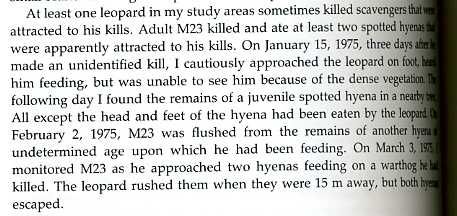





.jpg)
